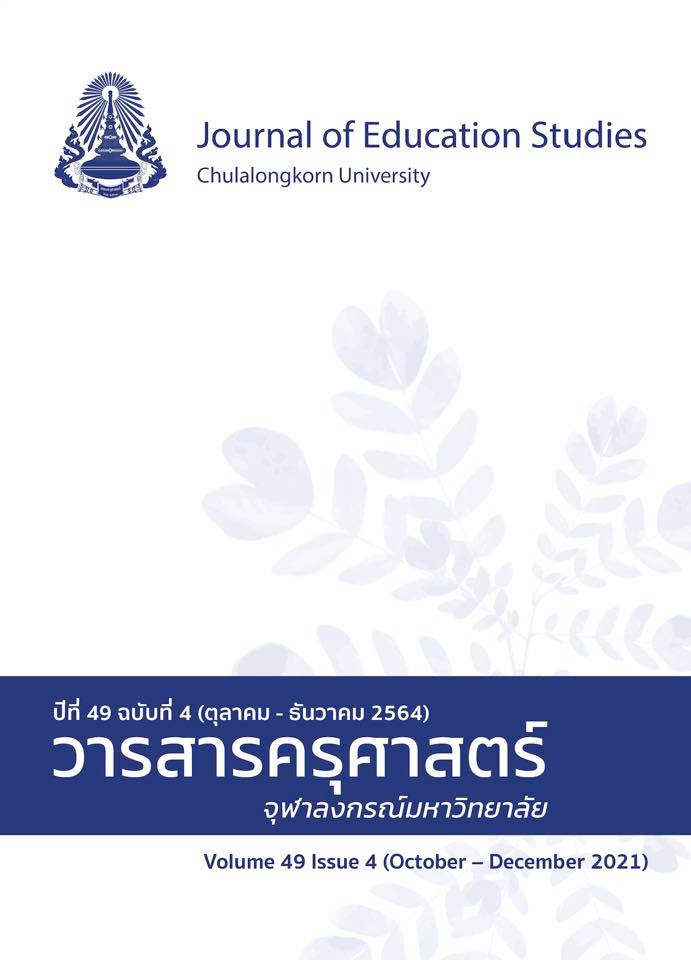The Effect of Teaching English with the Social Interaction Model on Students’ Motivation of English Language Learning in Fourth Grade Thai Students
DOI:
https://doi.org/10.14456/educu.2021.71Keywords:
social interaction model, motivation, fourth-grade studentsAbstract
This study aimed to promote students’ motivation to learn the English language through teaching using English with the social interaction model. The study consisted of 23 fourth-grade Thai students. Pre-experimental research was applied in this study with a one-group pre-test and post-test design. The participants were chosen bythe random sampling sample method which selected a single group (one class) from fourth-grade of the non-English program, the all members of the classes had an equal chance to be selected as participants. The research instruments in this study were designed lesson plans based on the Social Interaction Model and motivation questionnaire. Analysis in this study was measured by Paired Sample t-Test. The results indicated that teaching the English language with the Social Interaction Model may have a significant effect on students’ motivation to learn the English language. There was a statistically significant difference at the 0.5 level between the pre-test (M= 70.17, SD = 9.60) and the post-test (M= 74.78, SD = 5.87), (t = 2.16)
References
Apriliyanto, B., & Saputro, D. R. S. (2018). Student’s social interaction in mathematics learning. Journal of
Physics: Conference Series, 983(1), 012130.
Driscoll, M. P. (2000). Psychology of learning for instruction (2nd ed.). Allyn and Bacon.
Eggen, P., & Kauchak, D. (2016). Educational psychology: Windows on classrooms (10th ed.). Pearson
Education.
Ethnologue. (2020). What is the most spoken language?. https://www.ethnologue.com/guides/most-
spoken-languages
El-Omari, A. H. (2016). Factors affecting students’ achievement in English language learning. Journal of
Educational and Social Research, 6(2), 9. https://doi.org/10.5901/jesr.2016.v6n2p9
Gardner, R. C. (1985). Social psychology and second language learning: The role of attitude and
motivation. Edward Arnold.
Heng, K. (2017). Cambodian EFL university students’ learning strategies and motivation to improve their
English language speaking skills: A qualitative study. Journal of Studies in the English Language,
12(2), 45-70.
Ibrahim, N., Shak, M. S. Y., Mohd, T., Ismail, N. A., Perumal, P. D. a/p, Zaidi, A., & Yasin, S. M. A. (2015). The
Importance of implementing collaborative learning in the English as a Second Language (ESL)
classroom in Malaysia. Procedia Economics and Finance, 31, 346–353. https://doi.org/10.1016/s
2212-5671(15)01208-3
Jeanjaroonsri, R. (2018). A Study of constructive or restrictive features of classroom discourse in an EFL
adult classroom in Thai context. LEARN Journal: Language Education and Acquisition Research Network, 11(1), 125–139.
Kitjaroonchai, N. (2012a). Motivation toward English language learning of Thai students majoring in English
at Asia-Pacific International University. Human Behavior, Development and Society, 7(1), 21-40.
Kitjaroonchai, N. (2012b). Motivation toward English language learning of students in secondary and high
schools in education service area office 4, Saraburi Province, Thailand. International Journal of
Language and Linguistics, 1(1), 22-33. https://doi.org/10.11648/j.ijll.20130101.14
Matondang, N. D. S. Z. (2017). The effect of learning model and social interaction to student’s civic
education achievement in 5th grade. Journal of Research & Method in Education (IOSR-JRME),
7(4), 77–83. https://doi.org/10.9790/7388-0704047783
Morales, S. (2017). Relationship between social context and L2 learning of EFL students in tertiary level.
English Language Teaching, 10(10), 87-91. https://doi.org/10.5539/elt.v10n10p87
Muchemwa, S. (2015). Factors influencing the learning of English language for academic purposes for
foreign students: A case of Solusi University. Journal of Natural and Social Sciences, 4(3),
527-535.
Muho, A., & Kurani, A. (2011). The role of interaction in second language acquisition. European Scientific
Journal, 57(3), 350–355.
Patel, B. H. (2010). Social interaction model. Research in Education, 2(5), 1–6.
Poompanom, T. (2016). A survey study of students’ motivation towards English language learning of pre-
engineering school, Bangkok [Master's thesis]. Thammasat University Library. http://ethesisarchive.
library.tu.ac.th/thesis/2016/TU_2016_5621032381_5413_4083.pdf
Rao, P. S. (2019). Collaborative learning in English language classrooms. An International Multidisciplinary
Research Journal, 9(2), 5. https://doi.org/10.5958/2249-7137.2019.00020.x
Rainville, W. (2015). Motivation toward English language learning of English Major students at a Thai
public university [Unpubliched master's thesis]. Thammasat University.
Santrock, J. W. (2018). Educational psychology (6th ed.). McGraw-Hill Education.
Schunk, D. H., Meece, J. L., & Pintrich, P. R. (2014). Motivation in education: Theory, research, and
applications (4th ed.). Pearson.
Sejpal, K. (2013). Models of teaching: The way of learning. Rese, 2(3), 18–24.
Sousa, L. P. de Q., Tiraboschi, F. F., Lago, N. A. do, & Figueiredo, F. J. Q. de. (2019). Collaborative english
language learning: Some reflections from interactions between pairs. Trabalhos Em Linguística
Aplicada, 58(1), 259–286. https://doi.org/10.1590/010318138653439430941
Thailand English Proficiency. (2019). EF EPI 2019–EF English proficiency index – Thailand.
https://www.ef.co.th/epi/regions/asia/thailand/
Vialle, W., Lysaght, P., & Verenikina, I. (2005). Psychology for educators. Cengage Learning Australia.
Wardah, W. (2018). An analysis on the factors influencing the second language acquisition (students’
English learning achievement) of the Ushuluddin, Adab, and Da’wah students Al-Hikmah, 12(1).
https://doi.org/10.24260/al-hikmah.v12i1.1061
World Economic Forum. (2016). Which countries are best at English as a second language?.
https://www.weforum.org/agenda/2016/11/which-countries-are-best-at-english-as-asecond-language-4d24c8c8-6cf6-4067-a753-4c82b4bc865b/
Downloads
Published
How to Cite
Issue
Section
License

This work is licensed under a Creative Commons Attribution-NonCommercial-NoDerivatives 4.0 International License.




